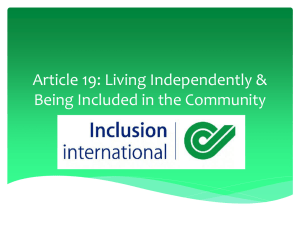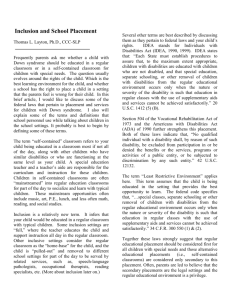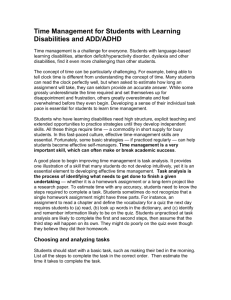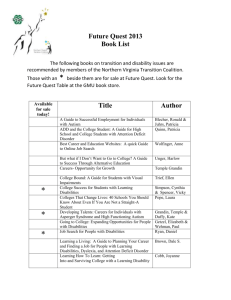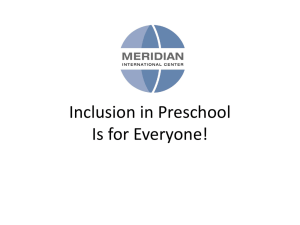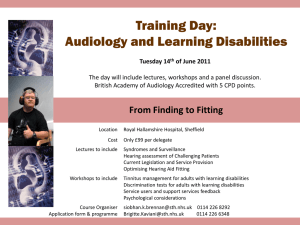NCIE - Special Education
advertisement
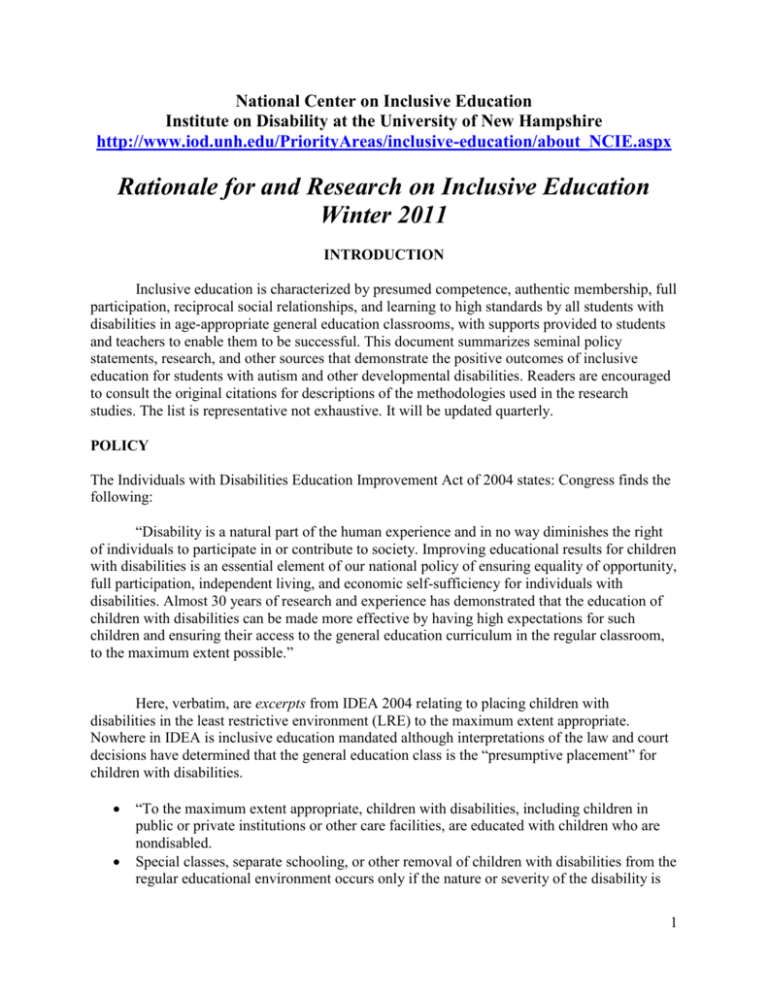
National Center on Inclusive Education Institute on Disability at the University of New Hampshire http://www.iod.unh.edu/PriorityAreas/inclusive-education/about_NCIE.aspx Rationale for and Research on Inclusive Education Winter 2011 INTRODUCTION Inclusive education is characterized by presumed competence, authentic membership, full participation, reciprocal social relationships, and learning to high standards by all students with disabilities in age-appropriate general education classrooms, with supports provided to students and teachers to enable them to be successful. This document summarizes seminal policy statements, research, and other sources that demonstrate the positive outcomes of inclusive education for students with autism and other developmental disabilities. Readers are encouraged to consult the original citations for descriptions of the methodologies used in the research studies. The list is representative not exhaustive. It will be updated quarterly. POLICY The Individuals with Disabilities Education Improvement Act of 2004 states: Congress finds the following: “Disability is a natural part of the human experience and in no way diminishes the right of individuals to participate in or contribute to society. Improving educational results for children with disabilities is an essential element of our national policy of ensuring equality of opportunity, full participation, independent living, and economic self-sufficiency for individuals with disabilities. Almost 30 years of research and experience has demonstrated that the education of children with disabilities can be made more effective by having high expectations for such children and ensuring their access to the general education curriculum in the regular classroom, to the maximum extent possible.” Here, verbatim, are excerpts from IDEA 2004 relating to placing children with disabilities in the least restrictive environment (LRE) to the maximum extent appropriate. Nowhere in IDEA is inclusive education mandated although interpretations of the law and court decisions have determined that the general education class is the “presumptive placement” for children with disabilities. “To the maximum extent appropriate, children with disabilities, including children in public or private institutions or other care facilities, are educated with children who are nondisabled. Special classes, separate schooling, or other removal of children with disabilities from the regular educational environment occurs only if the nature or severity of the disability is 1 such that education in regular classes with the use of supplementary aids and services cannot be achieved satisfactorily. [A school must] make provision for supplementary services (such as resource room or itinerant instruction) to be provided in conjunction with regular class placement. The child’s placement is determined at least annually is based on the child’s IEP and is as close as possible to the child’s home. Unless the IEP of a child with a disability requires some other arrangement, the child is educated in the school that he or she would attend if nondisabled. In selecting the LRE, consideration is given to any potential harmful effect on the child or on the quality of services that he or she needs. A child with a disability is not removed from education in age-appropriate regular classrooms solely because of needed modifications in the general education curriculum.” If schools can successfully educate a student in a general education classroom with peers who do not have disabilities, then the school must offer that educational experience. Students with disabilities do not need to keep up with students without disabilities in order to be educated in a general education classroom. Students with disabilities do not need to engage in the curriculum in the same way as students without disabilities in order to justify their inclusion. There are no legal or educational prerequisites to inclusion (Kluth, Villa, & Thousand, 2002). SOCIAL JUSTICE AND VALUING DIVERSITY “When school districts maintain segregated classrooms and separate schools for students with disabilities, such as children on the autism spectrum, this is not an educational necessity but instead reflects outdated and exclusionary attitudes. How children are treated in the schools often mirrors how they will be treated in later life. As with other minorities, segregated school placements lead to a segregated society, whereas inclusion in the earliest years promotes increased opportunity and greater understanding of differences for all involved. A society that separates its children is likely to maintain those separations indefinitely, reinforcing attitudinal barriers to inclusion in all aspects of life. Educating students with disabilities on an equal basis reflects the fundamental principle of modern democracy that all citizens deserve the right to claim a place in mainstream society. There are many options for inclusion available for Autistic students. Although inclusion encompasses more than simple integration and requires the hiring of additional teachers and other professionals who are knowledgeable about the specific educational needs of Autistics and other neurological minorities, the costs are minimal when compared to the impact of a lifetime of exclusion and underemployment. Providing an inclusive educational program is not only the right thing to do from an ethical and long-term societal perspective; it is also considerably less expensive for the taxpayers than building new segregated facilities, as some school districts have done in recent years” (Retrieved on January 15, 2011 from http://www.autisticadvocacy.org/modules/smartsection/category.php?categoryid=76). “TASH and its supporters actively seek to transform school communities based on social justice principles in which all students: are presumed competent, are welcomed as valued members of all general education classes and extra-curricular activities in their local schools, fully participate and learn alongside their same-age peers in general education instruction based 2 on the general curriculum, and, experience reciprocal social relationships” (Retrieved on January 16, 2011 from http://66.147.244.209/~tashorg/advocacy-issues/inclusive-education/). “Inclusion is not about disability, nor it is only about schools. Inclusion is about social justice…Inclusion demands that we ask, what kind of world do we want to create? …What kinds of skills and commitment do people need to thrive in diverse society?...By embracing inclusion as a model of social justice, we can create a world fit for all of us” (Sapon-Shevin, 2003, pp. 26, 28). High school students without disabilities have expressed support for inclusive education and the contribution that students with disabilities make to overall school diversity (Fisher, 1999). The presence of students with disabilities provides a catalyst for learning opportunities and experiences that might not otherwise be part of the curriculum, especially relating to social justice, prejudice, equity, and so forth (Evans, Salisbury, Palombaro, & Goldberg, 1994; Fisher, Sax, & Jorgensen, 1998). Based on the experiences reported by the participants, successful inclusion resulted in increased understanding of difference and diversity by the typically developing students in the classroom (Finke, McNaughton, & Drager, 2009). ACCESS TO THE GENERAL EDUCATION CURRICULUM IDEA requires that schools are accountable for showing how all students with disabilities are making progress in the general education curriculum (IDEA, 2004). In the Appendix to the No Child Left Behind Act of 2001’s implementing regulations, the U.S. Department of Education states “too often in the past, schools…have not expected students with disabilities to meet the same grade-level standards as other students. The NCLB Act sought to correct this problem by requiring each State to develop grade-level academic content and achievement standards that it expects all students—including students with disabilities—to meet.” Leaders in the field (Wehmeyer & Agran, 2006) identify the general education classroom as the optimal place where access to the general education curriculum occurs. ACADEMIC OUTCOMES Students with intellectual and other developmental disabilities educated in general education classrooms demonstrate better performance in reading and math (Cole, Waldron, & Majd, 2004) and significantly higher gains in adaptive behavior when compared with students with intellectual and other developmental disabilities educated in separate settings. 3 The largest, longitudinal study of education outcomes of 11,000 students with disabilities, the National Longitudinal Transition Study, showed that more time spent in a general education classroom was positively correlated with higher scores on standardized tests of reading and math, fewer absences from school, and fewer referrals for disruptive behavior. These results were independent of students’ disability, severity of disability, gender, or socio-economic status (Blackorby, Chorost, Garza, & Guzman, 2003). Results of studies on students’ academic outcomes revealed that students with severe disabilities have higher levels of academic responses and lower levels of competing behaviors when they are in general education classroom settings compared with the special education setting (Mortweet, Utley, Walker, Dawson, Delquadri, Reddy, Greenwood, Hamilton, & Ledford, 1999). In their case study describing the use of literacy before and after inclusion, Ryndak, Morrison, and Sommerstein (1999) found that when the services for a student with moderate to severe disabilities were changed from segregated special education classes to inclusive general education contexts, the student’s IEPs were designed better, her curriculum content was more consistent with that of her peers, and her instructional activities were more meaningful to her. Changes were also observed in the student’s behavior related to learning (e.g., time in instruction, time on task during instruction, motivation to acquire new skills; and her rate of learning over time. PROGRAM OUTCOMES In comparison to special education classroom, general education classrooms provided with more instruction, more whole class instruction, comparable one on one instruction, addressed academic content more, and utilized non-disabled peers more and adults less (Helmstetter, Curry, Brennan, & Sampson-Saul, 1998). The IEPs of students with severe disabilities educated in general education classrooms are of higher quality than those of students educated in separate special education classrooms; they include more academic skills, and goals and objectives that are more closely related to desired adult outcomes and roles (Hunt & Farron-Davis, 1992). The proportion of IEP objectives achieved was positively correlated with the amount of time students with severe disabilities spent in general education classes (Brinker & Thorpe, 1984). IEP teams that use a structured process for supporting students’ inclusion (e.g., The Beyond Access Model) report improved team collaboration, increased engagement and opportunities for learning by students, increased expectations for students’ learning, and reported improvement in academic and communication outcomes (Jorgensen, McSheehan, & Sonnenmeier, 2007; McSheehan, Sonnenmeier, Jorgensen, & Turner, 2006; Sonnenmeier, McSheehan, & Jorgensen, 2005). SOCIAL OUTCOMES 4 Kochhar, West, and Taymans (2000) draw from the research to conclude that students with disabilities benefit because inclusion facilitates more appropriate social behavior because of higher expectations in the general education classroom; offers a wide circle of support, including social support from classmates without disabilities; and improves the ability of students and teachers to adapt to different teaching and learning styles. The authors further contend that general education students also benefit from inclusion. For these students, inclusion leads to greater acceptance of students with disabilities, facilitates understanding that students with disabilities are not always easily identified, and promotes better understanding of the similarities among students with and without disabilities. Students with intellectual and other developmental disabilities in inclusive schools have a higher likelihood to be identified as a member of a social network by peers without disabilities (Kennedy & Itkonen, 1994). Students with disabilities demonstrate high levels of social interaction in settings with typical peers (Fryxell & Kennedy, 1995; Guralnick, Connor, Hammond, Gottman, & Kinnish, 1996). Social competence and communication skills improve when students with disabilities are educated in inclusive settings (Fisher & Meyer, 2002). Students with disabilities who are educated inclusive settings have demonstrated gains in areas of development such as level of engagement, involvement in integrated activities, affective demeanor, and social interaction (Hunt, Farron-Davis, Beckstead, Curtis, & Goetz, 1994). COMMUNICATION OUTCOMES Students with disabilities, including those who use augmentative and alternative communication, derive the following benefits from being included in general education classrooms: More opportunities for communication with peers and social interaction Increased interactions with peers Improved quality and functionality of communication goals and objectives on IEP Students are perceived as more capable (Beukelman & Mirenda, 2005; Broderick & Kasa-Hendrickson, 2001; Calculator & Jorgensen, 1992; Calculator & Jorgensen, 1991; Calculator & Jorgensen, 1994; Kent-Walsh & Light, 2003; McSheehan, Sonnenmeier, & Jorgensen, 2009; Soto, Muller, Hunt, & Goetz, 2001). POST-SCHOOL OUTCOMES The amount of time that students with disabilities spend in general education is positively correlated with better outcomes after high school in the areas of employment and independent living (Wagner, Newman, Cameto, Levine, & Garza, 2006). 5 TEACHER OUTCOMES Teachers confidence in their abilities to support inclusive education increases with experience, professional development, and other supports like time and resources (Fisher, Sax, Rodifer, & Pumpian, 1999; Giangreco, Dennis, Cloninger, Edelman, & Schattman, 1993). Successful inclusion has resulted increased understanding of teachers as teachers of all students, not just as teachers of children with disabilities (Finke, McNaughton, & Drager, 2009). In an ethnographic study of teachers who included students with autism in their classes, Kasa-Hendrickson (2005) found positive attitudes towards students’ competence. NEGATIVE EFFECTS OF SEGREGATED SETTINGS No studies conducted since the late 1970s have shown an academic advantage for students with intellectual and other developmental disabilities educated in separate settings (Falvey, 2004). In fact, studies have shown the following negative effects of separate special education placement: poorer quality IEPs (Hunt & Farron-Davis, 1992). lack of generalization to regular environments (Stokes & Baer, 1977) . disruption of opportunities for sustained interactions and social relationships with typical students (Strully & Strully, 2003). decrease in the confidence that general class teachers have for teaching diverse learners (Giangreco et al., 1993). absence of appropriate role and behavior models (Lovett, 1996). negative impact on classroom climate and student attitudes about difference (Fisher, Sax, Rodifer, & Pumpian, 1999). BENEFITS FOR STUDENTS WITHOUT DISABILITIES The performance of students without disabilities is not compromised by the presence of students with disabilities in their classrooms (Baker, Wang, & Walberg, 1994/1995; Cole, Waldron, & Majd, 2004; Idol, 2006; Staub & Peck, 1994). 6 REFERENCES Baker, E. T., Wang, M. C., & Walberg, H. J. (1994/1995). Synthesis of research: The effects of inclusion on learning. Educational Leadership, 52, 33–35. Beukelman, D., & Mirenda, P. (2005). Augmentative and alternative communication: Management of severe communication disorders in children and adults (3rd Ed.). Baltimore: Paul H. Brookes Publishing Co. Blackorby, J., Chorost, M., Garza, N., & Guzman, A. (2003). The academic performance of secondary students with disabilities. In M. Wagner, C. Marder, J. Blackorby, R. Cameto, L. Newman, & P. Levine, et al. (2003), The achievements of youth with disabilities during secondary school. A report from the National Longitudinal Transition Study – 2 (NLTS-2). Menlo Park, CA: SRI International. Brinker, R.P., & Thorpe, M.E. (1984). Integration of severely handicapped students and the proportion of IEP objectives achieved. Exceptional Children, 51, 168-175. Broderick, A., & Kasa-Hendrickson, C. (2001). ‘‘Say just one word at first’’: The emergence of reliable speech in a student labeled with autism. Journal of the Association for Persons with Severe Handicaps, 26(1), 13–24. Calculator, S., & Jorgensen, C. M. (1991). Integrating AAC instruction into regular education settings: Expounding on best practices. Augmentative and Alternative Communication, 7, 204-212. Calculator, S., & Jorgensen, C. M. (1992). A technical assistance model for promoting integrated communication supports and services for students with severe disabilities. Seminars in Speech and Language, 13(2), 99-110. Calculator, S., & Jorgensen, C. M. (1994). Including students with severe disabilities in schools: Fostering communication, interaction, and participation. San Diego, CA: Singular Publishing Group, Inc. Cole, C.M., Waldron, N., & Majd, M. (2004). Academic progress of students across inclusive and traditional settings. Mental Retardation, 42,136-144. Falvey, M. (2004). Towards realizing the influence of “Toward realization of the least restrictive environments for severely disabled students.” Research and Practice for Persons with Severe Disabilities, 29(1), 9-10. 7 Finke, E.H., McNaughton, D.B., & Drager, K.D. (2009). “All children can and should have the opportunity to learn”: General education teachers’ perspectives on inclusive children with autism spectrum disorder who require AAC. Augmentative and Alternative Communication, 25(2), 110-122. Fisher, D. (1999). According to their peers: Inclusion as high school students see it. Mental Retardation, 37(6), 458-467. Fisher, D., Sax, C., & Jorgensen, C. (1998). Philosophical foundations of inclusive, restructuring schools. In C. Jorgensen, Restructuring schools for all students: Taking inclusion to the next level (pp. 29-47). Baltimore: Paul H. Brookes Publishing Co. Inc. Fisher, D., Sax, C., Rodifer. K., & Pumpian, I. (1999). Teachers' perspectives of curriculum and climate changes: Benefits of inclusive education. Journal for a Just and Caring Education, 5, 256-268. Fisher, M., & Meyer, L. (2002). Development and social competence after two years for students enrolled in inclusive and self-contained educational programs. Research and Practice for Persons with Severe Disabilities, 27,165-174. Fryxell, D., & Kennedy, C. 11. (1995). Placement along the continuum of services and its impact on students' social relationships. Journal of the Association for Persons with Severe Handicaps, 20, 259-269. Giangreco, M. F., Dennis, R., Cloninger, C., Edelman, S., & Schattman, R. (1993). ‘‘I’ve counted Jon’’: Transformational experiences of teachers educating students with disabilities. Exceptional Children, 59(4), 359–372. Guralnick, M. J., Connor, R., Hammond, M., Gottman, J. M., & Kinnish, K. (1996). Immediate effects of mainstreamed settings on the social interactions and social integration of preschool children. American Journal on Mental Retardation, 100, 359-377. Helmstetter, E., Curry, C.A., Brennan, M., & Sampson-Saul, M. (1998). Comparison of general and special education classrooms of students with severe disabilities. Education and Training in Mental Retardation and Developmental Disabilities, 33(3), 216-227. Hunt, P., & Farron-Davis, F. (1992). A preliminary investigation of IEP quality and content associated with placement in general education versus special education classes. Journal of the Association for Persons with Severe Handicaps, 17, 247-253. Hunt, P., Farron-Davis, F., Beckstead, S., Curtis, D., & Goetz, L. (1994). Evaluating the effects of placement of students with severe disabilities in general education versus special classes. Journal of the Association for Persons with Severe Handicaps, 19, 200-214. Idol, L. (2006). Toward inclusion of special education students in general education. Remedial and Special Education, 27, 77-94. 8 Individuals with Disabilities Education Improvement Act, PL108-446, 20 U.S.C. §§1400 et seq. (2004). Jorgensen, C.M., McSheehan, M., & Sonnenmeier, R. (2007). Presumed competence reflected in the educational programs of students with IDD before and after the Beyond Access professional development intervention. Journal of Intellectual and Developmental Disabilities, 32(4), 248-262. Kasa-Hendrickson, C. (2005). ‘‘There’s no way this kid’s retarded’’: Teachers’ optimistic constructions of students’ ability. International Journal of Inclusive Education, 9(1), 55–69. Kennedy, C. H., & Itkonen, T. (1994). Some effects of regular class participation on the social contacts and social networks of high school students with severe disabilities. Journal of the Association for Persons with Severe Handicaps, 19, 1-10. Kent-Walsh, J., & Light, J. (2003). General education teachers’ experiences with inclusion of students who use augmentative and alternative communication. Augmentative and Alternative Communication, 19(2), 104-124. Kluth, P., Villa, R.A., & Thousand, J.S. (2002). “Our school doesn’t offer inclusion” and other legal blunders. Educational Leadership, December 2001/January 2002, 24-27. Kochhar, C. A., West, L. L., & Taymans, J. M. (2000). Successful inclusion: Practical strategies for a shared responsibility. Upper Saddle River, NJ: Prentice-Hall. Lovett, H. (1996). Learning to listen: Positive approaches and people with difficult behavior. Baltimore: Paul H. Brookes Publishing Co. Inc. Mortweet, S. L., Utley, C. A., Walker, D., Dawson, H. L., Delquadri, J. C., Reddy, S. S., Greenwood, C. R., Hamilton, S., & Ledford, D. (1999). Classwide peer tutoring: Teaching students with mild mental retardation in inclusive classrooms. Exceptional Children, 65, 524. McSheehan, M., Sonnenmeier, R.M., & Jorgensen, C.M. (2009). Membership, participation, and learning in general education classrooms for students with autism spectrum disorders who use AAC. In P. Mirenda & T. Iacono (Eds.), Autism spectrum disorders and AAC (pp. 413-442). Baltimore: Paul H. Brookes Publishing Co. McSheehan, M., Sonnenmeier, R., Jorgensen, C. M., & Turner, K. (2006). Promoting learning of the general education curriculum by students with significant disabilities. Topics in Language Disorders, 26(3), 266–290. No Child Left Behind Act, 20 U.S.C. §§ 6301 et seq. (2002); 34 C.F.R. §§ 200.1 et seq. (2003). 9 Ryndak, D., Morrison, A., & Sommerstein, L. (1999). Literacy before and after inclusion in general education settings: A case study. Journal of the Association for Persons with Severe Handicaps, 24(1), 5–22. Sapon-Shevin, M. (2003). Inclusion: A matter of social justice. Educational Leadership, 61(2), 25-28). Sonnenmeier, R., McSheehan, M., & Jorgensen, C. (2005). A case study of team supports for a student with autism’s communication and engagement within the general education curriculum: Preliminary report of the Beyond Access Model. Augmentative and Alternative Communication, 21(2), 101–115. Soto, G., Muller, E., Hunt, P., & Goetz, L. (2001). Critical issues in the inclusion of students who use augmentative and alternative communication: An educational team perspective. Augmentative and Alternative Communication, 17, 62 – 72. Staub, D., & Peck, C. A. (1994). What are the outcomes for nondisabled students? Educational Leadership, 52(4), 36-40. Stokes, T.F., & Baer, D.M. (1977). An explicit technology of generalization. Journal of Applied Behavior Analysis, 10, 349-367. Strully, J. & Strully, C. (2003). Inclusion: A road worth taking. Impact 16(1), 1 & 27-29. Minneapolis, MN: Institute for Community Inclusion, University of Minnesota. Theoharis, G., & Causton-Theoharis, J. Include, belong, learn. Retrieved January 25, 2010 from http://www.ascd.org/publications/educationalleadership/oct10/vol68/num02/Include,-Belong,-Learn.aspx. Wehmeyer, M., & Agran, M. (2006). Promoting access to the general curriculum for students with significant cognitive disabilities. In D. Browder, & F. Spooner (Eds.), Teaching language, arts, math, & science to students with significant cognitive disabilities (pp. 15–37). Baltimore: Paul H. Brookes Publishing Co. Inc. Wagner, M., Newman, L., Cameto, R., Garza, N., & Levine, P. (2005). After high school: A first look at the postschool experiences of youth with disabilities. A report from the National Longitudinal Transition Study-2(NLTS2). Menlo Park, CA: SRI International. Retrieved on January 15, 2011 from http://www.nlts2.org/reports/2005_04/nlts2_report_2005_04_complete.pdf. 10
